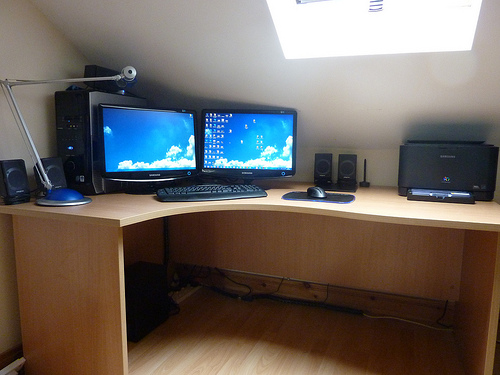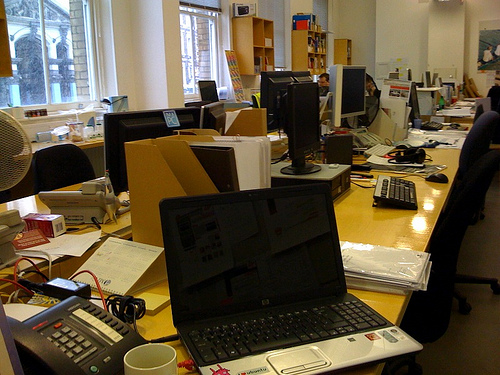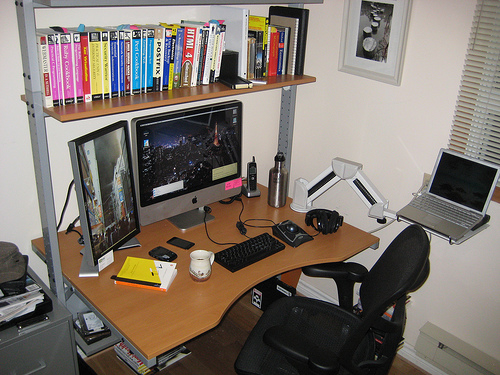One of these will surprise you.

Yeah, if you could stop interrupting my work every 15 minutes, that would be great…
Whenever I talk about working remotely, there’s always someone who thinks it wouldn’t fit a certain job type. (Curiously, it’s often the job of someone they don’t like.) “Oh, Management could never work remotely, you couldn’t keep a handle on everyone’s activity!”
Sure you could. It’s just a slightly different approach than randomly visiting desks and doling out orders, a la Mr. Lumbergh in Office Space.
The truth is, not only could Mr. Lumbergh’s job work remotely, so could almost every job ‘under’ his.
Which jobs in particular am I talking about? Let’s work up a list. More jobs than these are certainly possible, but this list will do for now.
- Creative Pros: Designers, Copywriters, Social Media Marketers
- Web Pros: Developers, UX Specialists
- Sales Reps
- Customer Service Reps
- Financial: Accounting, Financial Advisers, Bookkeeping
- Management
- IT: Support, App Development, Administration
- C-Level: CEO, COO, CIO
Quite a list, huh? Most of a business’ core functions and assistive roles are here. How could all of these roles work via telecommuting though? What makes them suitable for it?
Is Output Required? Then the Job is Remote-Work Suitable.
They all have one key factor in common. It’s a core principle of work, as old as humanity. These jobs are all dependent on, or characterized by, their OUTPUT.
The results they turn in. The processes they sustain. All based on the job’s output. If the job doesn’t produce a certain type of output, consistently and of good quality, then the person in that role isn’t doing their job.

Output in this case: Large quantities of paper. Photo by _foam 
Here’s an example of Output for each of the above jobs. If this is your role, take a moment to think about the work you do. Try to envision it all in a big, looking-down-from-above view. I think you’ll find these examples match up pretty closely.
- Designers: Digital assets available for use on the Web, in marketing campaigns, etc.
- Copywriters: Content available for use in websites and marketing campaigns.
- Social Media Marketers: Growing subscriber/follower counts, likes/shares, audience growth.
- Developers: Usable code for websites and online tools.
- UX Specialists: User Experience strategies for websites, tools, and other customer-facing resources.
- Sales Reps: Customers brought from lead to sale.
- Customer Service Reps: Low returns/refunds, high satisfaction scores, good reviews online.
- Accounting: Financials in good order. The business’ fiduciary requirements are met.
- Financial Advisers: Financial direction for future planning.
- Bookkeeping: Balanced books.
- Management: Smooth daily operations, good communications within & between departments.
- IT Support: Access to needed IT resources.
- App Development: Apps built & available to customers.
- Systems Administration: IT systems secured and fully functional.
- CEO/COO/CIO: Stock price growth, smart future decisions.
We have quite an assortment of output here. Everything from the “useful in a business setting” to “critical for everyday function.” A business could work without some, for a while. Some—I’m looking at you, “balanced books”—are so important that without them a business can implode in minutes!
And yet…absolutely NONE of these output examples require a physical presence in an office all the time. Only a focus on the output is necessary. (Which is what you want anyway, right? Good healthy productivity?)
How to Adapt Jobs to Working Remotely (Easier Than You Think)
What changes would a business need to make all of these jobs work from a remote setting?
You’d need certain business processes in place. The good news is, almost all of the jobs will work remotely using the same processes. Nothing incredibly unusual is required.
- Establish a communication standard. One way to communicate that everyone has & can rely on. Phone and email are always there, of course. But I’m talking more about real-time communications tools: Instant Messaging, Slack, and so on. I’ll address tools like these in more detail soon.
- Security between the worker’s computer and the company’s IT resources. The WannaCry attack recently knocked the world for a loop. If nothing else, it emphasized the importance of good strong cybersecurity. Said cybersecurity must protect everyone’s computers (and the data on them), irrespective of environment.
- Reliable employees empowered to maintain their own output. More of a philosophical position than a practical process. But it pays dividends when each employee knows they can and should focus on doing their best work.
- Project tracking/management system. A way to monitor & guide projects to completion. Pretty much necessary nowadays, since people have a lot to do, and projects have many moving parts. I like Asana myself. But you have many other excellent options: Trello, Basecamp, Workfront, Wrike, etc. Try some out, see which you like the most.
Now, here’s the kicker. Any well-run business will need all of these processes anyway! Remote work or not.
Thus adapting them for Remote Work is not a difficult or obstructive task. In fact, you may already have some or all of them in place.
So what’s holding you back from Remote Work? Just the decision. The recognition that most modern jobs are suitable for Remote Work. More than you thought before.
When will you decide?






